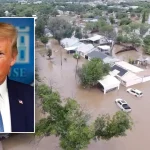
Speaker Mike Johnson on Texas floods: ‘We feel just as helpless as everyone else’.
Posted in :
Texas’ devastating 2025 floods claimed 78 lives, including 28 children in Kerr County alone. As communities grieve and search for the missing continues, Speaker Mike Johnson’s remarks highlight both the emotional toll and the bureaucratic delays in providing aid. Real recovery requires more than words—it demands swift action and long-term planning.
A candid exploration of the devastating 2025 Texas floods, focusing on Kerr County’s heartbreaking loss, the emotional weight on leaders like Speaker Mike Johnson, and the gritty stories of survival emerging from the heart of the disaster. The post weaves statistics, personal narratives, and a behind-the-scenes look at policy responses, capturing the messy reality of calamity and recovery.
Rain against the window used to lull me to sleep, but the relentless downpour that hammered Texas in May 2025 woke up an entire state. With each news alert—another fatality, another neighbor missing—the floods in Kerr County forced families, leaders, and first responders to rethink what ‘helpless’ really means. Some disasters make the news; others change you forever. This is one of those stories.
Caught in the Downpour: What the Numbers Reveal (& What They Can’t)
When the Texas floods of 2025 hit, the headlines came fast—numbers, statistics, and official statements. But behind each number is a story that can’t be summed up in a chart or a press release. Kerr County, in particular, became the face of heartbreak, with the Kerr County flood death toll reaching a staggering 68, including 28 children. Statewide, the flood death toll in Texas climbed to at least 78, and the search continues for at least 41 people still missing across Texas.
The numbers are shocking, but they only scratch the surface. Every statistic is a family changed forever, a community left picking up the pieces. As research shows, Kerr County bore the brunt of the disaster—68 out of 78 deaths statewide happened here. That’s not just a number. That’s neighbors, classmates, friends, and loved ones. The floodwaters didn’t just wash away homes; they swept away futures, too.
In the immediate aftermath, local church halls became makeshift shelters. Volunteers—some with trembling hands, others with tears in their eyes—passed out blankets and hot drinks. One neighbor, who had never spoken much before, quietly handed out supplies to anyone who needed them. It was a scene repeated all over Kerr County and beyond, as Texas flood survivors clung to each other for comfort.
“When the water came, we barely had time to grab our shoes.”
‘When the water came, we barely had time to grab our shoes.’ – Texas flood survivor
That’s how one survivor described the chaos. The water rose so quickly, there was no time to think—just run. For many, there was no warning at all. The Texas floods 2025 didn’t discriminate. Children at camp, parents at home, seniors in their living rooms—everyone was vulnerable.
The numbers—68 lost in Kerr County, 28 of them children—are almost too much to process. And yet, the reality is even heavier. At least 41 people are still missing across Texas, their families waiting for news, clinging to hope as rescue and recovery teams continue their search. The scale of the disaster is hard to grasp, even for those living through it.
Speaker Mike Johnson put it simply in a recent interview: “In a moment like this, we feel just as helpless as everyone else does.” He spoke of how the floods touched so many families, including members of Congress whose own children were at camps in the flood zone. Johnson emphasized that every available resource—from FEMA to local first responders—has been deployed, but the sense of helplessness lingers. There’s only so much that can be done while the search for Texas flood victims continues.
Research indicates that the human toll is evident not just in the numbers, but in the faces and voices of those left behind. The Kerr County flood death toll is more than a statistic—it’s a measure of loss, of interrupted lives, and of a community’s resilience. Emergency funding and federal disaster declarations have brought help, but the real work is happening on the ground, in church basements and community centers, where survivors gather and volunteers do what they can.
Every headline tells a number; every statistic is a shattered family. The Texas flood survivors are living proof that the impact of the 2025 floods goes far beyond what any official report can capture. As stories begin to emerge from these makeshift shelters, it’s clear that the numbers, while important, can never tell the whole story.
The search for the missing continues. The numbers may change, but the heartbreak remains. In Kerr County and across Texas, the true cost of the floods is measured not just in lives lost, but in the strength of those left behind to rebuild.
Leaders on the Edge: When Even Congress Feels Helpless
There are moments when even the highest offices in the country seem powerless against nature’s fury. The Texas floods of 2025 have been one of those moments. As the death toll in Kerr County soared and families waited for word on missing loved ones, the usual confidence of Capitol Hill gave way to something rare: vulnerability. Speaker Mike Johnson, usually a steady hand in the storm of politics, summed up the mood in Washington with a simple, honest admission:
“In a moment like this, we feel just as helpless as everyone else does.”
It’s not every day you hear the Speaker of the House say that. But these aren’t ordinary days. The Texas flood response has stretched every resource—local, state, and federal—to its limits. And yet, as Johnson explained on Fox News Sunday, there’s a frustrating reality to the way Congress works. No matter how urgent the need, legislative action on Texas floods can’t move forward until the official requests for Congress supplemental funding land on lawmakers’ desks.
Personal Ties: When Lawmakers Become Victims, Too
What makes this disaster different is how close it has hit to home for so many in Congress. Speaker Johnson, whose own district is in Louisiana, reached out to Rep. Chip Roy of Texas—whose constituents are among the hardest hit. The connections don’t stop there. Rep. August Pfluger’s daughters were at a summer camp that was swept up in the flooding. Rep. Buddy Carter’s granddaughters were there, too. Suddenly, the faces on the news weren’t just strangers. They were family.
Johnson didn’t shy away from this personal side. “It touches so many families, and all we know to do at this moment is pray,” he said. It’s a reminder that behind every headline about federal resources for flood relief, there are real people—some of them sitting in Congress—waiting for news, hoping for a miracle.
Behind the Curtain: The Machinery of Federal Response
So, what’s actually happening behind the scenes? According to Speaker Johnson, “Every available resource has been deployed. The president, of course, is dialed in and watching this develop moment by moment, as we are.” Federal agencies like FEMA and the Department of Homeland Security have mobilized, working alongside state teams in the hardest-hit areas. Research shows that government agencies have moved quickly, but the scale of the disaster in Kerr County—where 68 of the state’s 78 deaths have been reported—means the need is overwhelming.
Still, the gears of Congress turn slowly. Johnson made it clear: “We will handle supplemental funding requests as they come in, but right now they’re still trying to do rescue and recovery, and our hearts go out to all of them.” It’s a waiting game, dictated by process and paperwork, even as the need for emergency funding in Texas floods grows more urgent by the hour.
What If Help Came as Fast as the Rain?
It’s hard not to wonder—what if Congress could move as quickly as the floodwaters? What if emergency funding for Texas floods arrived with the same speed as the rain that devastated Kerr County? The reality is, bureaucracy doesn’t bend to the weather. Even with lawmakers personally affected, even with the president watching closely, the system has its own pace.
But there’s something different about this moment. The human side of the crisis—lawmakers with loved ones in harm’s way—has brought a new urgency to the debate over legislative action on Texas floods. The lines between policymaker and victim have blurred. It’s not just about numbers on a page or votes in a chamber. It’s about families, survival, and loss.
For now, Congress stands ready, waiting for the official call to act. The Texas flood response, as Speaker Mike Johnson put it, is a test of both government and humanity. And in this moment, even the most powerful leaders are reminded of their limits—and their shared vulnerability with the people they serve.
Survivors, Unsung: Rescues, Camp Stories, and Grit Amid the Rising Water
In the heart of Kerr County, as the Texas floods of 2025 swept through with a force no one could have truly prepared for, stories of survival and heartbreak began to emerge from the rising water. The numbers alone are staggering—research shows at least 78 lives lost statewide, with Kerr County carrying the heaviest burden at 68 fatalities, including 28 children. But behind every statistic is a story, and nowhere did those stories feel more raw than at the summer camps nestled along the riverbanks, like Camp Mystic.
The chaos that unfolded at Camp Mystic was nothing short of terrifying. Water rose with a speed that left no time for second-guessing. Seconds truly mattered. Counselors and campers scrambled for higher ground, some clinging to trees or rooftops as the current threatened to sweep them away. Among those caught in the floodwaters were the daughters of Rep. August Pfluger and the granddaughters of Rep. Buddy Carter—proof that disaster doesn’t discriminate, touching families from every walk of life. The impact of the Texas floods on families, both local and far-flung, was immediate and deeply personal.
As the rain hammered down, rescue operations kicked into high gear. Local fire departments, many staffed by volunteers, became overnight heroes. These were neighbors, friends, and sometimes strangers, risking everything to pull others from danger. Federal and local teams, including the Federal Emergency Management Agency (FEMA) and the Department of Homeland Security, coordinated with boots on the ground. Helicopters hovered overhead, spotlights cutting through the storm, while boats navigated treacherous currents below. Research indicates that FEMA’s swift deployment and ongoing coordination with local responders were critical in saving lives and beginning the long road to recovery.
But it wasn’t just the professionals who stepped up. In the darkest hours, as the floodwaters crept higher and the power flickered out, the spirit of community shone through. There’s a story—one that’s already become legend among the survivors—of a group of teens huddled together in a camp cabin, singing “Lean on Me” by lantern light. The song drifted out into the night, a fragile thread of hope tying them together as they waited for rescue. Moments like these, small and almost quiet, are what many will remember long after the water recedes.
Behind the scenes, the search for missing persons in Kerr County continued around the clock. Families clung to hope, sharing photos and memories, waiting for any scrap of news. The heartbreak was palpable, but so was the resilience. Survivors spoke of trauma, yes, but also of tenacity—of the grit that kept them moving forward even when the odds seemed impossible. As one local volunteer put it, “You just keep going. You help the next person, and then the next. That’s all you can do.”
Federal and state officials, including Speaker Mike Johnson, acknowledged the scale of the disaster and the limits of what could be done in the immediate aftermath. In his words,
“All we know to do at this moment is pray.”
Johnson emphasized that every available resource had been deployed, and that Congress would address supplemental funding as requests came in. For now, though, the focus remained on rescue and recovery—on finding the missing, comforting the grieving, and supporting the survivors.
As the days stretched on, the stories coming out of Kerr County and the surrounding areas painted a picture of both devastation and defiance. The Texas flood rescue operations were relentless, and the Texas flood survivors’ stories became a testament to the human spirit’s ability to endure. The impact of the Texas floods on families will linger for years, but so will the memories of courage, compassion, and community. In the end, it’s the unsung survivors—the campers, the rescuers, the families waiting in the dark—who remind us what it means to hold onto hope, even when the waters rise.
TL;DR: Texas’ 2025 floods left deep scars—nearly 70 lives lost in Kerr County alone and dozens still missing. As survivors share tales of heartbreak and hope, officials work on next steps. Recovery here is not just about numbers, but the people and decisions shaping what comes next.
TexasFloodingUpdates, KerrCountyFloodDeathToll, TexasFloodSurvivors, TexasFloodDeathToll, TexasFloods2025, FederalEmergencyResponse, TexasFloodRescueOperations, TexasFloodVictims, EmergencyFundingTexasFloods, ImpactTexasFloodsFamilies,Texasfloods SpeakerMikeJohnsonresponse, KerrCountyflooddeathtoll2025, FEMAdisasterresponseTexas, GOPleadersfloodstatements, Texasfloodsurvivorsstories
#TexasFlood2025, #KerrCountyStrong, #FloodRecovery, #DisasterResponse, #TexasNews, #FloodSurvivors, #PrayForTexas, #CongressUpdates,#TexasFloods #MikeJohnson #FEMA #DisasterResponse #KerrCounty #TexasEmergency #FloodSurvivors #CongressFloodRelief #FederalAid #CommunityResilience

